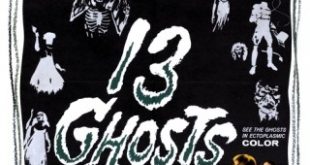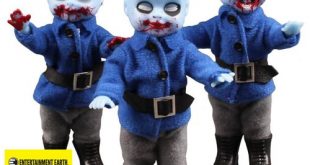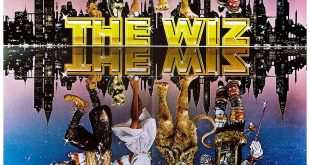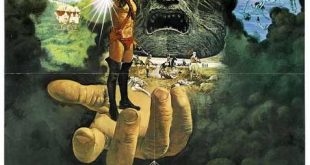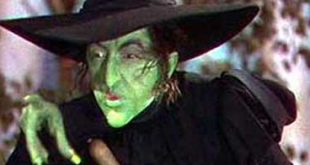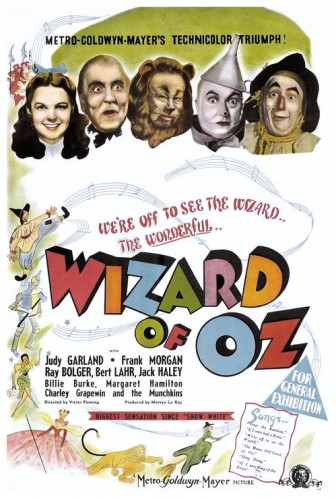 SYNOPSIS:
SYNOPSIS:
“When a nasty neighbor tries to have her dog put to sleep, Dorothy takes her dog Toto, to run away. A cyclone appears and carries her to the magical land of Oz. Wishing to return, she begins to travel to the Emerald City where a great wizard lives. On her way she meets a Scarecrow who needs a brain, a Tin Man who wants a heart, and a Cowardly Lion who desperately needs courage. They all hope the Wizard of Oz will help them, before the Wicked Witch of the West catches up with them.” (courtesy IMDB)
REVIEW:
There weren’t many radical or genuinely original fantastic films made during the forties. The horror bubble had burst as the real horror of world war approached, and the genre was largely represented by perfunctory sequels to much better films. What was new was an increasing sophistication in special effects, a greater overall polish, a move from black-and-white to colour film stock, and a general emphasis on good taste. Suspense was replacing actual fright; ghosts tended to appear only discreetly and usually to upper-class persons; the Devil was whimsical rather than actually evil; science fiction disappeared almost completely; werewolves were likable tormented souls; the new King of Horror was a pudgy sad-eyed Lon Chaney Junior; and the supernatural was met with wisecracking sophistication.
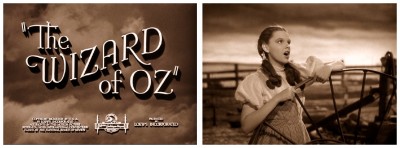 What was usually missing was the idea of the fantastic as being any sort of projection of internal fears or torments. Perhaps the world of that day held enough external fears. Also, the darker side of life (the Hollywood version) was tending to appear in the so-called Film Noir rather than in outright fantasies: B-grade movies about police, gangsters, revenge and doomed love. On the other hand, fantasy still had an important role to play in the brightly exotic side of life, and never more so than in the fantastic world of The Wizard Of Oz (1939). The effect this Hollywood classic has had on Americans cannot be overestimated. Its influence on filmmakers alone is profound – it’s often joked that every film since 1939 includes some reference to it, and I’m not so sure this isn’t true.
What was usually missing was the idea of the fantastic as being any sort of projection of internal fears or torments. Perhaps the world of that day held enough external fears. Also, the darker side of life (the Hollywood version) was tending to appear in the so-called Film Noir rather than in outright fantasies: B-grade movies about police, gangsters, revenge and doomed love. On the other hand, fantasy still had an important role to play in the brightly exotic side of life, and never more so than in the fantastic world of The Wizard Of Oz (1939). The effect this Hollywood classic has had on Americans cannot be overestimated. Its influence on filmmakers alone is profound – it’s often joked that every film since 1939 includes some reference to it, and I’m not so sure this isn’t true.
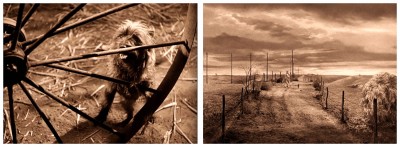 This is the ultimate family film. Adults can be assured that their rebellious children, like Dorothy (Judy Garland), will discover their need for home and family. Young children will be excited by its fairy-tale elements, a journey into a strange land, scary moments (Margaret Hamilton) is wonderfully frightening as the Wicked Witch), and a dazzling assortment of characters: a wizard (Frank Morgan), a good witch (Billie Burke), Munchkins, flying monkeys, a scarecrow without a brain (Ray Bolger), a tin man without a heart (Jack Haley), and a lion without courage (Bert Lahr). There’s also catchy songs, a castle, horses of different colour, talking apple trees with lousy attitudes, and many spectacular occurrences provided by Metro-Goldwyn-Mayer‘s special effects department.
This is the ultimate family film. Adults can be assured that their rebellious children, like Dorothy (Judy Garland), will discover their need for home and family. Young children will be excited by its fairy-tale elements, a journey into a strange land, scary moments (Margaret Hamilton) is wonderfully frightening as the Wicked Witch), and a dazzling assortment of characters: a wizard (Frank Morgan), a good witch (Billie Burke), Munchkins, flying monkeys, a scarecrow without a brain (Ray Bolger), a tin man without a heart (Jack Haley), and a lion without courage (Bert Lahr). There’s also catchy songs, a castle, horses of different colour, talking apple trees with lousy attitudes, and many spectacular occurrences provided by Metro-Goldwyn-Mayer‘s special effects department.
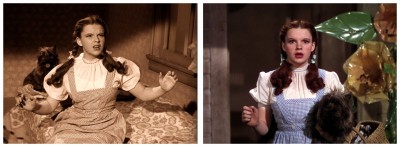 The screenplay was fundamentally a committee job with eight or more contributors, but the result was quite true to the sometimes dark and often grotesque vision of L. Frank Baum, who wrote the original novel in 1900. But the film has greatest meaning to teenage girls who live drab lives in drab environments and dream of escaping over a rainbow and finding a glamorous life. Kansas represents their dreary existence, and Oz represents Hollywood, to which teenage girls dream of running in the hope of breaking into movies. Our heroes get a beauty treatment and even win awards. The Emerald City represents MGM and the Wizard is Louis B. Mayer. That teenagers subconsciously equate Oz with Hollywood isn’t so ridiculous when one considers the picture was meant to showcase the best Hollywood could muster in the way of production values.
The screenplay was fundamentally a committee job with eight or more contributors, but the result was quite true to the sometimes dark and often grotesque vision of L. Frank Baum, who wrote the original novel in 1900. But the film has greatest meaning to teenage girls who live drab lives in drab environments and dream of escaping over a rainbow and finding a glamorous life. Kansas represents their dreary existence, and Oz represents Hollywood, to which teenage girls dream of running in the hope of breaking into movies. Our heroes get a beauty treatment and even win awards. The Emerald City represents MGM and the Wizard is Louis B. Mayer. That teenagers subconsciously equate Oz with Hollywood isn’t so ridiculous when one considers the picture was meant to showcase the best Hollywood could muster in the way of production values.
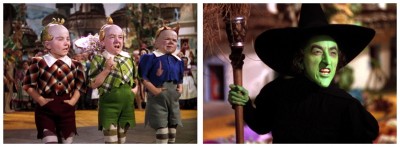 Dorothy’s journey could also be interpreted as young girl’s last childhood experience and, when she chooses to return home to Kansas at the end, she has matured into a young woman. It’s at this point they should have removed the straps holding Garland’s well-developed breasts in place to make her look eleven years old and not sixteen. Of course, the film’s theme “There’s No Place Like Home” is absolute nonsense. Unlike in Baum’s novel, Oz (without the Wicked Witch) is a wonderful place for Dorothy to stay. It’s much more preferable to sepia-toned Kansas, where she was lonely except for having Toto (who was going to be taken away) and lived with an unsupportive and elderly uncle and aunt on a very barren grey farm. Am I the only one who thinks she should stay in brightly coloured Oz with all her new friends?
Dorothy’s journey could also be interpreted as young girl’s last childhood experience and, when she chooses to return home to Kansas at the end, she has matured into a young woman. It’s at this point they should have removed the straps holding Garland’s well-developed breasts in place to make her look eleven years old and not sixteen. Of course, the film’s theme “There’s No Place Like Home” is absolute nonsense. Unlike in Baum’s novel, Oz (without the Wicked Witch) is a wonderful place for Dorothy to stay. It’s much more preferable to sepia-toned Kansas, where she was lonely except for having Toto (who was going to be taken away) and lived with an unsupportive and elderly uncle and aunt on a very barren grey farm. Am I the only one who thinks she should stay in brightly coloured Oz with all her new friends?
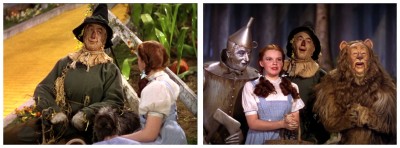 The Wizard Of Oz is not necessarily a great film, but it is definitely joyous and has deservedly become a classic, although it was declared a flop on its initial release, taking over two decades to recover its very high production cost of US$2.7 million. Despite the adult propaganda and a few flaws along the way, it has considerable humour and imagination, great songs and dances, colourful characters and, of course, the peerless Judy Garland. We are delighted by her dynamic yet touching performance, yet grieve because we know this is the role that launched her into the world of super=stardom she was never able to handle. When she so beautifully sings “Over The Rainbow” we sense that it is Garland as much as Dorothy who is seeking peace and happiness. We want to warn her to be careful once she makes it over the rainbow.
The Wizard Of Oz is not necessarily a great film, but it is definitely joyous and has deservedly become a classic, although it was declared a flop on its initial release, taking over two decades to recover its very high production cost of US$2.7 million. Despite the adult propaganda and a few flaws along the way, it has considerable humour and imagination, great songs and dances, colourful characters and, of course, the peerless Judy Garland. We are delighted by her dynamic yet touching performance, yet grieve because we know this is the role that launched her into the world of super=stardom she was never able to handle. When she so beautifully sings “Over The Rainbow” we sense that it is Garland as much as Dorothy who is seeking peace and happiness. We want to warn her to be careful once she makes it over the rainbow.
 The real stars of the film are the three vaudevillians who played the Tin Man, the Scarecrow and the Cowardly Lion: Jack Haley, Ray Bolger and Bert Lahr, particularly Lahr, whose delivery – honed by years of stage work, derives full comic weight from each drawled syllable. The other star (not Judy Garland as Dorothy who, even then, played sadness more convincingly than happiness, and was obviously too old for the role) was Arnold Gillespie, for many years head of the MGM special effects team. The effects, from the Kansas tornado through to the flying monkeys, are still a wonder to behold. The Munchkins (two hundred midgets according to some reports) are an appropriately fantastic introduction to the world of Oz. There is a very professional performance from the terrier who played Toto (earning a mere US$125 for her owner), and several of the songs are terrific.
The real stars of the film are the three vaudevillians who played the Tin Man, the Scarecrow and the Cowardly Lion: Jack Haley, Ray Bolger and Bert Lahr, particularly Lahr, whose delivery – honed by years of stage work, derives full comic weight from each drawled syllable. The other star (not Judy Garland as Dorothy who, even then, played sadness more convincingly than happiness, and was obviously too old for the role) was Arnold Gillespie, for many years head of the MGM special effects team. The effects, from the Kansas tornado through to the flying monkeys, are still a wonder to behold. The Munchkins (two hundred midgets according to some reports) are an appropriately fantastic introduction to the world of Oz. There is a very professional performance from the terrier who played Toto (earning a mere US$125 for her owner), and several of the songs are terrific.
 Like It’s A Wonderful Life (1946), Night Of The Hunter (1955) and Carnival Of Souls (1962), The Wizard Of Oz is one of several films whose classic status has largely come about through regular replays on television. Victor Fleming directed, Mervyn LeRoy produced, Harold Rosson did the cinematography, Harold Arlen contributed the music, and E.Y. Harburg wrote the lyrics. If you wish to find out more about the making of The Wizard Of Oz, there have been dozens of books published over the years, and there’s a few I can recommend: The Ruby Slippers Of Oz by Rhys Thomas (1989), The Munchkins Of Oz by Stephen Cox (1996), The Wizardry Of Oz by Jay Scarfone and William Stillman (2004), and Memories Of A Munchkin by Meinhardt Raabe and Daniel Kinske (2005), but the best place to start would be the extensive article found at Wikipedia. Hold that thought, and I’ll politely ask you to please join me again next week to discover if Hollywood has yielded up another work of substance, or a nonsensical bit of fluff for…Horror News! Toodles!
Like It’s A Wonderful Life (1946), Night Of The Hunter (1955) and Carnival Of Souls (1962), The Wizard Of Oz is one of several films whose classic status has largely come about through regular replays on television. Victor Fleming directed, Mervyn LeRoy produced, Harold Rosson did the cinematography, Harold Arlen contributed the music, and E.Y. Harburg wrote the lyrics. If you wish to find out more about the making of The Wizard Of Oz, there have been dozens of books published over the years, and there’s a few I can recommend: The Ruby Slippers Of Oz by Rhys Thomas (1989), The Munchkins Of Oz by Stephen Cox (1996), The Wizardry Of Oz by Jay Scarfone and William Stillman (2004), and Memories Of A Munchkin by Meinhardt Raabe and Daniel Kinske (2005), but the best place to start would be the extensive article found at Wikipedia. Hold that thought, and I’ll politely ask you to please join me again next week to discover if Hollywood has yielded up another work of substance, or a nonsensical bit of fluff for…Horror News! Toodles!
 Horror News | HNN Official Site | Horror Movies,Trailers, Reviews
Horror News | HNN Official Site | Horror Movies,Trailers, Reviews

